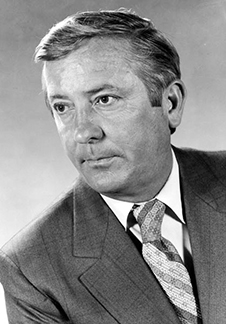
Les Gaver
Public Affairs, NASA
If a picture is worth a thousand words, then Les Gaver’s work, during a more than 30 year career, was worth hundreds of millions of words.
When Les Gaver joined the embryonic NASA in July 1960 as chief of Audio Visual activities for Public Affairs, it was just beginning to acquire the facilities that it would need for a program with widespread international interest. There was not even a permanent Headquarters in Washington, and Gaver’s office was on the second floor of the old Dolly Madison House, adjacent to the White House.
His first work at NASA’s Kennedy Space Center was arranging photo coverage of the Echo I launch that year. The very first communications satellite, Echo was a large aluminized balloon structure for bouncing radio waves off from a transmitter in one part of the world to a receiver located thousands of miles away.
Early in August 1960, he started working with Shorty Powers and the original seven astronauts to make sure their activities were documented. Gaver was able to have photographer Bill Taub assigned to his office to cover all the training and their travel.
A frequent visitor at Kennedy, Gaver orchestrated still and motion picture coverage of prelaunch and launch activities for hundreds of expendable and human spaceflights. In the early days, all of the media activities were headquartered at offices in Cocoa Beach or Cape Canaveral. Through the Apollo program the Cape and Kennedy were off limits to media except at launch time, and even then, escorts were required. This meant photographers and news people went to an office on the beach, and Gaver, working with the Kennedy staff, arranged escorts, transportation and often combined groups to cover the news. Television pooling of NASA camera feeds was the way most launches were covered, and Gaver spent much of his time making sure there was agreement between the various media and NASA. Much of the coverage of activities was on 16mm film and it was normal to have to rush film to an airport to ship it to Washington or New York.
During Gemini and Apollo, a major part of Gaver’s job was directing and producing the television feeds to the world’s media. This continued on into the shuttle program.
Throughout the Apollo lunar landing program, he was the editor of all film shot on the lunar surface, both still and motion picture.
Just as he did at Kennedy, Gaver traveled to many of the other NASA centers to oversee the audio/visual events of major missions ranging from training activities to missions to other planets.
As the Space Shuttle Program was gearing up, Gaver persuaded Kennedy to send its audio/visual coordinator Gatha Cottee to Dryden Flight Research Center in California to set up the system for covering the drop tests. Gaver then flew out to direct the photo and television releases during the actual events.
Despite the busy travel schedule and oversight of photo and television coverage of programs across the country, Gaver handled all the audio/visual activities at the White House and congressional levels. He produced and directed the television coverage of the hearings during the shuttle Challenger accident investigation which had worldwide interest.
For the last ten years of his career, he was also the executive producer of the satellite feed known as NASA Select Television.

























